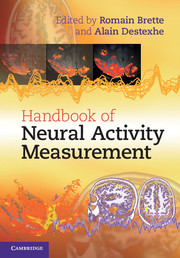Book contents
- Frontmatter
- Contents
- List of contributors
- 1 Introduction
- 2 Electrodes
- 3 Intracellular recording
- 4 Extracellular spikes and CSD
- 5 Local field potentials
- 6 EEG and MEG: forward modeling
- 7 MEG and EEG: source estimation
- 8 Intrinsic signal optical imaging
- 9 Voltage-sensitive dye imaging
- 10 Calcium imaging
- 11 Functional magnetic resonance imaging
- 12 Perspectives
- Plate section
- References
7 - MEG and EEG: source estimation
Published online by Cambridge University Press: 05 October 2012
- Frontmatter
- Contents
- List of contributors
- 1 Introduction
- 2 Electrodes
- 3 Intracellular recording
- 4 Extracellular spikes and CSD
- 5 Local field potentials
- 6 EEG and MEG: forward modeling
- 7 MEG and EEG: source estimation
- 8 Intrinsic signal optical imaging
- 9 Voltage-sensitive dye imaging
- 10 Calcium imaging
- 11 Functional magnetic resonance imaging
- 12 Perspectives
- Plate section
- References
Summary
Introduction
In magnetoencephalography (MEG) and electroencephalography (EEG), scalp potentials and extracranial magnetic fields generated by electrical activity in the brain are detected non-invasively (Berger, 1929; Cohen, 1972) (for an overview of the methodology see, e.g., Hamalainen et al., 1993; Niedermeyer and Lopes da Silva, 1999; Michel et al., 2009; Hansen et al., 2010). MEG and EEG signals are superpositions of contributions from sources at different locations in the brain. Source estimation (also known as inverse modeling) refers to the problem of determining the spatiotemporal patterns of neural activity on the basis of the recorded signals (Figure 7.1). The specific goal in source estimation can be stated in two closely related ways: (a) to identify the locations of the sources of the measured signals as a function of time, or (b) to disentangle the contributions from different brain regions in the measured time-varying signals. The often used term source localization refers to the former, whereas spatiotemporal imaging emphasizes the latter, reflecting the use of MEG and EEG source estimation in the analysis of the dynamical activity in networks of brain areas.
A given source in the brain generates a characteristic spatial pattern of signals in arrays of MEG and EEG sensors. These patterns can be calculated by using a forward model (see Chapter 6). In source estimation, the measured spatial patterns of signals are analyzed in order to make inferences about the distribution of the sources in the brain.
- Type
- Chapter
- Information
- Handbook of Neural Activity Measurement , pp. 257 - 286Publisher: Cambridge University PressPrint publication year: 2012
References
- 5
- Cited by

